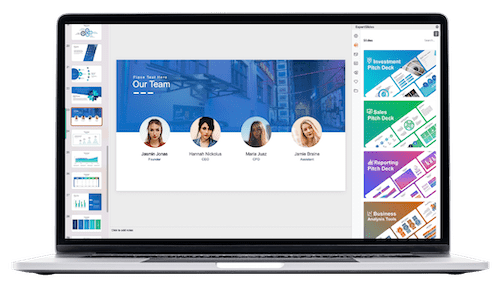Creating Concise Presentations: A Detailed Overview of One Pager Template PowerPoint
Table of Contents
PowerPoint presentation is key for professional to share his ideas, proposal and report in a good looking way. But when slides are too long or got too much words on it audience might start not paying attention or not catch crucial info. That’s when one-pager PowerPoint templates steps in the scene.
These templates smooshes all needed info into one slide, this make it more simple for the speaker to share his point briefly and for them audience to get it quick. One-pagers be really flexible too so they’re good for lots of things like project news, selling products or telling about a business. In these thorough overviews we talk over everything you gotta know ’bout making brief presentations by using one-pager PowerPoint templates.
What is a One-Pager PowerPoint Template?

One page PowerPoint template be a standalone slide that show all important details in short and with good looking design. It stick to the “less is more” idea where presenter try to deliver his or her message clear by using little words and keeping visuals simple. One-pagers often get used for presenting needing fast look like project progress business one pager strategies or pitching products they can double as handouts or something you leave behind documents once presentation done.
A one-pager, which peoples also call a single-page summary or executive overview, usually carries the most important points facts and pictures to back up what the presenter’s tryna say. Them aim to grab listeners’ focus quick and deliver the central thought straight and brief. This type of summaries got a fixed format that includes parts like start bit, issue being outlined solutions or suggestions plus sides gained, wrapping it all up in the end part. One pagers be flexible too let folks put their own stamp on it using things like their logos and handpicked colors.
You can make one-page PowerPoint templates on you own or get them from different websites online. Plenty of companies and persons gives away free templates for one-pagers that are simple to tweak for what someone needs. But it’s important to pick a template that fit with the
The Importance of Creating Concise Presentations
Nowadays in the quick-moving world time and attention is a scarce resource. Lengthy text-dense slideshows often loses audiences interest and not succeeds in giving out their message right. This is when single-page PowerPoint layouts becomes valuable for experts.
A big plus of making short presentations be that they save time for the presenter and their audience. A one-sheet template squishes all needed info onto just one slide, cutting out having lots of slides and long-winded talkings. It let the speaker get their point across fast and without wasting time so there’s more room for talking or questions-answers after.
Furthermore, brief displays that use single page formats is often more visually attractive and hold attention better than older-style presentations. By using striking images and less words presenters grabs the audience interest and keeps them interested for the whole show. It helps in remembering stuff too cause folks usually recall pictures better than written things.
A big plus to make short presentations is they fits for lots of different uses. Single pages used for stuff like project news, pitching products, telling about your company and things like that. Them also can be shared quick over email or you can print them out to give people a handy way to get the info.
Step By Step Guide to Creating a One-Pager PowerPoint Template

Creating a one-pager PowerPoint template may seem daunting at first, but with the right approach, it can be an easy and efficient process. Here is a step by step guide to creating your own one-pager presentation:
Define the purpose of your presentation
The first and most crucial step in creating a one-pager PowerPoint template is to define the purpose of your presentation. This will help you determine the key points and information that need to be included in your one-pager. For example, if you are presenting a project update, you may want to include the project’s status, goals achieved, and upcoming milestones. On the other hand, if you are pitching a new product, you may want to include information about its features, benefits, and target market.
Defining the purpose of your presentation will also help in determining the appropriate tone and style for your one-pager. For instance, a project update may require a more professional and formal tone, while a product pitch can be more creative and persuasive.
It is also essential to consider your audience while defining the purpose of your presentation. Knowing who will be attending and their level of understanding can help in tailoring the information accordingly. This will ensure that your one-pager effectively conveys the intended message and resonates with your audience.
Identify the key points to be included
Once you have defined the purpose of your presentation, it is crucial to identify the key points that need to be included in your one-pager. These can be the main ideas, data, or statistics that support your message and help in conveying it concisely.
To determine the key points, consider the most important information that your audience needs to know. This can also be based on the goals or objectives of your presentation. For example, if your goal is to persuade the audience, then you may want to highlight the benefits or advantages of your proposal.
It is also important to prioritize and limit the number of key points included in your one-pager. Too much information can overwhelm the audience and defeat the purpose of creating a concise presentation. Keep in mind that the goal of a one-pager is to summarize and highlight the most important information, not to include every detail.
Choose a suitable one-pager template or create your own design
After defining the purpose and identifying the key points, it is time to choose a suitable one-pager template or create your own design. There are various online sources that offer free one-pager templates, or you can design one from scratch using PowerPoint‘s features.
When choosing a template, consider its layout and design elements. Make sure it aligns with your branding and effectively presents your information in a visually appealing way. You can also customize the template according to your needs, such as changing the colors or adding your logo.
If you choose to design your own one-pager, keep it simple and avoid overcrowding the slide. Use a consistent color scheme and font style to maintain cohesiveness throughout the presentation. You can also add visual elements, such as icons or images, to make your one-pager more engaging.
Add your branding elements, such as logos and colors
Incorporating your branding elements, such as logos and colors, is an important step in creating a one-pager PowerPoint template. This not only adds a professional touch to your presentation but also helps in reinforcing your brand identity.
Make sure to use high-quality images of your logo and choose colors that align with your branding. Using too many colors can be distracting, so stick to a simple and consistent color scheme. You can also consider using your brand’s font for a cohesive look.
By including your branding elements, you are creating a visual representation of your company or project, making it easier for the audience to remember and associate with it.
Use simple and concise language to convey your message effectively
One of the key advantages of creating a one-pager PowerPoint template is to convey information in a concise and easy-to-understand manner. Therefore, it is important to use simple and straightforward language to effectively convey your message.
Avoid using technical jargon or complex sentences that may confuse or bore the audience. Instead, use short and clear sentences to get your point across. You can also use bullet points to break down information and make it more digestible.
It is also essential to proofread your one-pager for any spelling or grammatical errors. These mistakes can undermine the credibility of your presentation, so make sure to double-check before finalizing the content.
Utilize visuals, charts, and graphs to support your information
Visual aids, such as charts and graphs, can greatly enhance the effectiveness of your one-pager PowerPoint template. They not only make the presentation more visually appealing but also help in presenting data or statistics in a more digestible format.
When using visuals, choose ones that are relevant to your content and support your key points. Avoid overcrowding the slide with too many visuals, as it can be overwhelming for the audience. You can also use icons or images to add visual interest and break up text-heavy slides.
Make sure to label your charts and graphs clearly and use a simple design that is easy to understand at a glance. This will ensure that your visuals effectively support your information without causing confusion.
Proofread for any spelling or grammatical errors
The important final step in creating your one-pager PowerPoint template is to proofread for any spelling or grammatical errors. These mistakes can undermine the credibility of your presentation and distract from your message.
Make sure to read through your one-pager carefully, checking for any typos or grammar errors. You can also ask someone else to review it for a fresh perspective and catch any mistakes that you may have missed.
In addition to proofreading for errors, it is also a good idea to review the content and make sure it effectively conveys your message. Make any necessary edits or revisions to ensure that your one-pager is concise, clear, and impactful.
By following these steps and continuously reviewing and revising your one-pager PowerPoint template, you can ensure that it effectively conveys your message and leaves a lasting impression on your audience. Remember to keep it concise, visually appealing, and aligned with your branding for maximum impact.
Practice your presentation to ensure a smooth delivery.
Finally, after creating and finalizing your one-pager PowerPoint template, it is crucial to practice your presentation to ensure a smooth delivery. This will help you become more familiar with the content and feel more confident during the actual presentation.
Practice delivering your presentation out loud to get a sense of timing and make sure all points are covered. You can also record yourself and watch it back to identify any areas that may need improvement.
If possible, practice in front of a small audience and ask for their feedback. This will not only help you improve your presentation skills but also give you an idea of how your audience may respond to the content.
Utilize visuals, charts, and graphs to support your information
Visual aids, such as charts and graphs, can greatly enhance the effectiveness of your one-pager PowerPoint template. They not only make the presentation more visually appealing but also help in presenting data or statistics in a more digestible format.
When using visuals, choose ones that are relevant to your content and support your key points. Avoid overcrowding the slide with too many visuals, as it can be overwhelming for the audience. You can also use icons or images to add visual interest and break up text-heavy slides.
Make sure to label your charts and graphs clearly and use a simple design that is easy to understand at a glance. This will ensure that your visuals effectively support your information without causing confusion.
Proofread for any spelling or grammatical errors
The important final step in creating your one-pager PowerPoint template is to proofread for any spelling or grammatical errors. These mistakes can undermine the credibility of your presentation and distract from your message.
Make sure to read through your one-pager carefully, checking for any typos or grammar errors. You can also ask someone else to review it for a fresh perspective and catch any mistakes that you may have missed.
In addition to proofreading for errors, it is also a good idea to review the content and make sure it effectively conveys your message. Make any necessary edits or revisions to ensure that your one-pager is concise, clear, and impactful.
By following these steps and continuously reviewing and revising your one-pager PowerPoint template, you can ensure that it effectively conveys your message and leaves a lasting impression on your audience. Remember to keep it concise, visually appealing, and aligned with your branding for maximum impact.
Practice your presentation to ensure a smooth delivery.
Finally, after creating and finalizing your one-pager PowerPoint template, it is crucial to practice your presentation to ensure a smooth delivery. This will help you become more familiar with the content and feel more confident during the actual presentation.
Practice delivering your presentation out loud to get a sense of timing and make sure all points are covered. You can also record yourself and watch it back to identify any areas that may need improvement.
If possible, practice in front of a small audience and ask for their feedback. This will not only help you improve your presentation skills but also give you an idea of how your audience may respond to the content.
Where to use your one-pager PowerPoint template
You can use your one-pager PowerPoint template in different places like business meeting conference or pitches. It be a flexible tool for effectively communicate you message and show off you brand with visual appeal.
Beside them settings you can use you one-pager on your company website or social media platform for introduce the company or project to more people. This helps in making interests and pulling in potential client or investor.
Also think about using you one-pager as something to leave behind after presentation or meeting. It can acts as a reminder for your main points and help set you brand in minds of audience.
Where to not use your one-pager PowerPoint template
Your one-pager PowerPoint template could be a mighty tool for present information but sometimes it might not suitable to use’s them. For instance if you give a long and detail presentation, a one-pager mightn’t give enough room to cover all the infos properly.
In the same way for academic or science environments where lots of data or studies is showed a one-pager might not be most effective layout.
You got to check the situation and what you aimin’ for with your talk before picking to go with that single-page PowerPoint template of yours. If it fits right in with what you wants to achieve, then it could turn out real useful.
But if it not convey all the information that be needed sometimes is best to choose a longer and more detailed format for presentation. So always think about where you are and who listening before you decide to go with your one-pager PowerPoint template.
FAQs
What is a one pager document in the context of a PowerPoint presentation?
A one pager document within a PowerPoint presentation context refers to a concise, single-page layout designed to present key information succinctly. This format is ideal for summarizing complex information, such as a business plan or marketing strategy, into an easily digestible format. By focusing on the essential elements, a one pager ensures that the audience can quickly grasp the core message without being overwhelmed by details.
How can I use a one pager for my business plan presentation?
Using a one pager for your business plan presentation allows you to highlight the most critical aspects of your plan on a single page. Start by identifying the key elements that define your business strategy, such as objectives, target market, competitive advantage, and financial highlights. Arrange these elements strategically on the page to create a visually engaging and informative summary. This approach helps stakeholders quickly understand your business vision and direction.
Can one pager templates be used for marketing strategy presentations in Google Slides?
Yes, one pager templates can be adapted for marketing strategy presentations in Google Slides as well as PowerPoint. These templates provide a versatile foundation for showcasing your marketing plan’s main components, such as goals, target audience, channels, and key messages, all on a single page. The simplicity and clarity of a one pager make it an effective tool for communicating your marketing strategy to team members, stakeholders, or clients across different presentation platforms.
What are the benefits of presenting complex information in a single page through a one pager?
Presenting complex information in a single page through a one pager offers several benefits, including improved clarity, enhanced focus, and increased audience engagement. By distilling information down to its essence, a one pager forces presenters to prioritize the most relevant data, ensuring that the audience can easily follow along. This format also facilitates quicker decision-making by providing a clear and concise overview of critical points, making it an excellent tool for executive summaries, project updates, and strategic overviews.
Conclusion
To wrap up a single-page PowerPoint template is really useful to get your point across clear and with visual attraction. Stick into these advice and rules you can make a striking one-pager that has a long-lasting impact on people watching it.
Make sure you speak plainly and clear, use pictures for to help show your info, check over for mistake, rehearse your talk and think about the situation careful when you using a one-pager.
Using them strategies you can present your ideas confidently and show off you brand with a professional one-pager PowerPoint template start creating your one-pager today to make powerful impact in your next presentation Happy designing!
Related Blogs
Get 7+ Mio. PowerPoint Assets - FREE SIGN-UP

Sign up for free to our PowerPoint extension, ExpertSlides. Everything you need, directly in PowerPoint. No credit card required.
Related Posts
